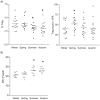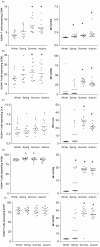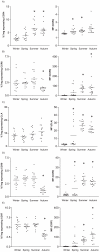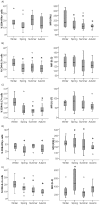Seasonal variation in vitamin D₃ levels is paralleled by changes in the peripheral blood human T cell compartment
- PMID: 22235276
- PMCID: PMC3250425
- DOI: 10.1371/journal.pone.0029250
Seasonal variation in vitamin D₃ levels is paralleled by changes in the peripheral blood human T cell compartment
Abstract
It is well-recognized that vitamin D₃ has immune-modulatory properties and that the variation in ultraviolet (UV) exposure affects vitamin D₃ status. Here, we investigated if and to what extent seasonality of vitamin D₃ levels are associated with changes in T cell numbers and phenotypes. Every three months during the course of the entire year, human PBMC and whole blood from 15 healthy subjects were sampled and analyzed using flow cytometry. We observed that elevated serum 25(OH)D₃ and 1,25(OH)(2)D₃ levels in summer were associated with a higher number of peripheral CD4+ and CD8+ T cells. In addition, an increase in naïve CD4+CD45RA+ T cells with a reciprocal drop in memory CD4+CD45RO+ T cells was observed. The increase in CD4+CD45RA+ T cell count was a result of heightened proliferative capacity rather than recent thymic emigration of T cells. The percentage of Treg dropped in summer, but not the absolute Treg numbers. Notably, in the Treg population, the levels of forkhead box protein 3 (Foxp3) expression were increased in summer. Skin, gut and lymphoid tissue homing potential was increased during summer as well, exemplified by increased CCR4, CCR6, CLA, CCR9 and CCR7 levels. Also, in summer, CD4+ and CD8+ T cells revealed a reduced capacity to produce pro-inflammatory cytokines. In conclusion, seasonal variation in vitamin D₃ status in vivo throughout the year is associated with changes in the human peripheral T cell compartment and may as such explain some of the seasonal variation in immune status which has been observed previously. Given that the current observations are limited to healthy adult males, larger population-based studies would be useful to validate these findings.
Conflict of interest statement
Figures






Similar articles
-
The Migratory Properties and Numbers of T Regulatory Cell Subsets in Circulation Are Differentially Influenced by Season and Are Associated With Vitamin D Status.Front Immunol. 2020 May 19;11:685. doi: 10.3389/fimmu.2020.00685. eCollection 2020. Front Immunol. 2020. PMID: 32508805 Free PMC article.
-
Regulation of cytokine responses by seasonality of vitamin D status in healthy individuals.Clin Exp Immunol. 2011 Apr;164(1):72-9. doi: 10.1111/j.1365-2249.2010.04315.x. Epub 2011 Feb 16. Clin Exp Immunol. 2011. PMID: 21323660 Free PMC article.
-
Low-Dose Vitamin D3 Supplementation Does Not Affect Natural Regulatory T Cell Population but Attenuates Seasonal Changes in T Cell-Produced IFN-γ: Results From the D-SIRe2 Randomized Controlled Trial.Front Immunol. 2021 Jun 28;12:623087. doi: 10.3389/fimmu.2021.623087. eCollection 2021. Front Immunol. 2021. PMID: 34262557 Free PMC article. Clinical Trial.
-
High-dose vitamin D3 supplementation is a requisite for modulation of skin-homing markers on regulatory T cells in HIV-infected patients.AIDS Res Hum Retroviruses. 2013 Feb;29(2):299-306. doi: 10.1089/AID.2012.0051. Epub 2012 Aug 29. AIDS Res Hum Retroviruses. 2013. PMID: 22720723
-
Thymic commitment of regulatory T cells is a pathway of TCR-dependent selection that isolates repertoires undergoing positive or negative selection.Curr Top Microbiol Immunol. 2005;293:43-71. doi: 10.1007/3-540-27702-1_3. Curr Top Microbiol Immunol. 2005. PMID: 15981475 Review.
Cited by
-
Seasonal Variation of Blood Calcium Levels in Children Aged 1-10.J Clin Lab Anal. 2016 Sep;30(5):741-4. doi: 10.1002/jcla.21931. Epub 2016 Apr 7. J Clin Lab Anal. 2016. PMID: 27061272 Free PMC article.
-
Contribution of vitamin D insufficiency to the pathogenesis of multiple sclerosis.Ther Adv Neurol Disord. 2013 Mar;6(2):81-116. doi: 10.1177/1756285612473513. Ther Adv Neurol Disord. 2013. PMID: 23483715 Free PMC article.
-
The role of CD4+FoxP3+ regulatory T cells in the immunopathogenesis of COVID-19: implications for treatment.Int J Biol Sci. 2021 Apr 10;17(6):1507-1520. doi: 10.7150/ijbs.59534. eCollection 2021. Int J Biol Sci. 2021. PMID: 33907514 Free PMC article. Review.
-
New perspectives on vitamin D sources in Germany based on a novel mathematical bottom-up model of 25(OH)D serum concentrations.Eur J Nutr. 2013 Oct;52(7):1733-42. doi: 10.1007/s00394-012-0477-3. Epub 2012 Dec 11. Eur J Nutr. 2013. PMID: 23229408
-
The Effect of Holder Pasteurization and Different Variants on Breast Milk Antioxidants.Antioxidants (Basel). 2023 Oct 13;12(10):1857. doi: 10.3390/antiox12101857. Antioxidants (Basel). 2023. PMID: 37891936 Free PMC article.
References
Publication types
MeSH terms
Substances
LinkOut - more resources
Full Text Sources
Research Materials

